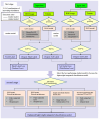A Lightweight Breast Cancer Mass Classification Model Utilizing Simplified Swarm Optimization and Knowledge Distillation
- PMID: 40564456
- PMCID: PMC12189441
- DOI: 10.3390/bioengineering12060640
A Lightweight Breast Cancer Mass Classification Model Utilizing Simplified Swarm Optimization and Knowledge Distillation
Abstract
In recent years, an increasing number of women worldwide have been affected by breast cancer. Early detection is crucial, as it is the only way to identify abnormalities at an early stage. However, most deep learning models developed for classifying breast cancer abnormalities tend to be large-scale and computationally intensive, often overlooking the constraints of cost and limited computational resources. This research addresses these challenges by utilizing the CBIS-DDSM dataset and introducing a novel concatenated classification architecture and a two-stage strategy to develop an optimized, lightweight model for breast mass abnormality classification. Through data augmentation and image preprocessing, the proposed model demonstrates a superior performance compared to standalone CNN and DNN models. The two-stage strategy involves first constructing a compact model using knowledge distillation and then refining its structure with a heuristic approach known as Simplified Swarm Optimization (SSO). The experimental results confirm that knowledge distillation significantly enhances the model's performance. Furthermore, by applying SSO's full-variable update mechanism, the final model-SSO-Concatenated NASNetMobile (SSO-CNNM)-achieves outstanding performance metrics. It attains a compression rate of 96.17%, along with accuracy, precision, recall, and AUC scores of 96.47%, 97.4%, 94.94%, and 98.23%, respectively, outperforming other existing methods.
Keywords: convolutional neural networks; knowledge distillation; lightweight breast cancer mass classification model; simplified swarm optimization.
Conflict of interest statement
The authors declare no conflicts of interest.
Figures

















Similar articles
-
Cost-effectiveness of using prognostic information to select women with breast cancer for adjuvant systemic therapy.Health Technol Assess. 2006 Sep;10(34):iii-iv, ix-xi, 1-204. doi: 10.3310/hta10340. Health Technol Assess. 2006. PMID: 16959170
-
The clinical effectiveness and cost-effectiveness of enzyme replacement therapy for Gaucher's disease: a systematic review.Health Technol Assess. 2006 Jul;10(24):iii-iv, ix-136. doi: 10.3310/hta10240. Health Technol Assess. 2006. PMID: 16796930
-
A review: Lightweight architecture model in deep learning approach for lung disease identification.Comput Biol Med. 2025 Aug;194:110425. doi: 10.1016/j.compbiomed.2025.110425. Epub 2025 Jun 14. Comput Biol Med. 2025. PMID: 40517598 Review.
-
Advanced glaucoma disease segmentation and classification with grey wolf optimized U -Net++ and capsule networks.Int Ophthalmol. 2025 Jun 27;45(1):266. doi: 10.1007/s10792-025-03602-6. Int Ophthalmol. 2025. PMID: 40576831
-
Molecular feature-based classification of retroperitoneal liposarcoma: a prospective cohort study.Elife. 2025 May 23;14:RP100887. doi: 10.7554/eLife.100887. Elife. 2025. PMID: 40407808 Free PMC article.
References
-
- World Health Organization. International Agency for Research on Cancer . GLOBOCAN 2012: Estimated Cancer Incidence, Mortality and Prevalence Worldwide in 2012. IARC Publications; Lyon, France: 2012.
-
- Rangayyan R.M., Ayres F.J., Desautels J.L. A review of computer-aided diagnosis of breast cancer: Toward the detection of subtle signs. J. Frankl. Inst. 2007;344:312–348. doi: 10.1016/j.jfranklin.2006.09.003. - DOI
-
- Sardanelli F., Aase H.S., Álvarez M., Azavedo E., Baarslag H.J., Balleyguier C., Baltzer P.A., Beslagic V., Bick U., Bogdanovic-Stojanovic D., et al. Position paper on screening for breast cancer by the European Society of Breast Imaging (EUSOBI) and 30 national breast radiology bodies from Austria, Belgium, Bosnia and Herzegovina, Bulgaria, Croatia, Czech Republic, Denmark, Estonia, Finland, France, Germany, Greece, Hungary, Iceland, Ireland, Italy, Israel, Lithuania, Moldova, The Netherlands, Norway, Poland, Portugal, Romania, Serbia, Slovakia, Spain, Sweden, Switzerland and Turkey. Eur. Radiol. 2017;27:2737–2743. - PMC - PubMed
-
- Debelee T.G., Schwenker F., Ibenthal A., Yohannes D. Survey of deep learning in breast cancer image analysis. Evol. Syst. 2020;11:143–163. doi: 10.1007/s12530-019-09297-2. - DOI
Grants and funding
LinkOut - more resources
Full Text Sources

